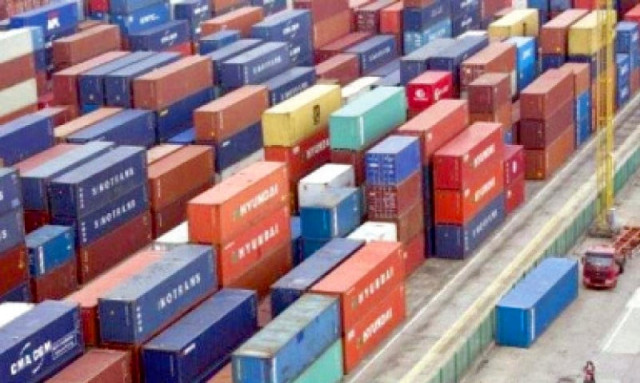Re-evaluating our import strategy
Rising imports risk a BoP crisis, IMF bailouts, making it crucial to rethink import strategy

The recent trends in economic activity, particularly the inflation rate, inspire optimism about Pakistan's economic conditions. The inflation rate has dropped to its lowest level in nearly four years, while the trade deficit remains stable at around $5.4 billion in the first quarter of the fiscal year. Exports, standing at $5 billion, have increased by almost 15%, and imports have risen by 7% in the first two months of the fiscal year. The foreign exchange reserves at the State Bank of Pakistan (SBP) increased to over $10.7 billion as of September 27, 2024, following the receipt of a new tranche from the International Monetary Fund (IMF) earlier in the month. Although the current business confidence index is still in negative territory, the expected business confidence is in the positive zone, with businesses anticipating improved economic conditions over the coming months. The business community is particularly focused on the policy rate, expecting a significant cut in interest rates in the upcoming monetary policy statement.
One of the primary concerns regarding the recovery of economic activity is the rise in imports, which could lead to another balance-of-payments crisis. This cyclical pattern forces Pakistan to repeatedly approach the IMF for assistance. It is essential that Pakistan breaks free from this cycle, which requires a rethinking of the country's import strategy, as this directly impacts its domestic productive capacities.
Import demand is expected to rise as inflation declines, increasing the purchasing power of domestic consumers, and as interest rates decrease. This shift may influence consumption patterns, leading to greater demand for imports. Fuel products account for approximately 30% of Pakistan's total imports, while consumer goods such as tea and palm oil are also among the largest import categories. In contrast, imports of textile machinery and intermediate goods in the textile industry have declined over the past two years, as producers have faced restrictions on their ability to import. The decline in business activity due to the inability to import essential capital goods and inputs has adversely affected productivity and competitiveness. Therefore, as the economy enters a recovery phase, it is crucial to ensure that the right mix of products is importedthose that promote productivity growth and enhance competitiveness.
It is important to note that Pakistan imposes some of the highest tariff rates in the region and has one of the lowest rates of manufacturing value-added and exports as a percentage of GDP. Pakistan lacks economic complexity, primarily producing goods with low levels of sophistication. Import restrictions and the inability to acquire goods that promote technological progress exacerbate the challenges businesses face.
As foreign exchange reserves accumulate and the immediate risk of a balance-of-payments crisis diminishes, there is likely to be an increase in import demand. However, challenges remain. According to data from Global Trade Alert, Pakistan not only has a relatively complex web of import interventions but has also disproportionately affected imports of capital and intermediate goods more than those of consumer goods. For example, even though the textile industry generates the largest exports for Pakistan, the country's imports of textile machinery are smaller than those of its major regional counterparts. According to trade data from ITC's Trademap.org, Pakistan imported $140 million worth of textile machinery in 2023less than one-fourth of what Bangladesh imported. Imports of knitting and weaving machines, which contribute more to value-added production than spinning, amounted to less than $40 million. In contrast, Pakistan saw a surge in textile machinery imports in 2021, totalling approximately $700 million.
Pakistan must also ensure that its imports shift toward more environmentally friendly goods and reduce its dependency on fuel imports. A report published by the Consortium for Development Policy Research (CDPR), titled "Trade Policy Measures to Encourage a Shift towards Green Technologies," highlights the need to reduce tariffs on various environmental goods imported into Pakistan. The report notes that Pakistan imposes some of the highest average tariff rates on such goods in the region, while the average tariffs on non-environmental goods are lower. Additionally, Pakistan lacks the application of technical non-tariff measures that could enhance product quality and consumer safety, both essential for preventing the dumping of substandard goods. If Pakistan reduces tariffs on environmental goods to the average rate of 8% imposed by India, it could increase its total imports by $1 billion. Furthermore, Pakistan is reported to have some of the cheapest solar panel imports globally, thanks to favourable policies. As the world moves toward renewable energy, it is imperative that policymakers encourage the adoption of cleaner energy technologies. In fact, the shift toward greener energy sources will soon become a prerequisite for exporting to several developed countries.
The share of IT-related goods in Pakistan's total imports is one of the lowest in the region. The lack of imports of technologically advanced goods hinders firms in both the manufacturing and services sectors from reaching the technological frontiers of their industries. As a result, businesses risk losing their competitiveness in regional and global markets due to their inability to adopt more sophisticated production methods, which are becoming increasingly prevalent worldwide. Encouraging the adoption of advanced IT-related products is essential. An article written by this author in The Express Tribune suggests that eliminating tariffs on IT-related imports would increase these imports by $2 billion, which could, in turn, boost Pakistan's GDP by 2% over the next decade. Easier access to high-tech products would not only improve consumer welfare but also enhance producers' productivity as they adopt production processes closer to the global technological frontier.
In essence as Pakistan's economic indicators continue to improve, it is critical to reshape the country's import policy to promote long-term growth, sustainability, and competitiveness.
THE WRITER IS THE ASSISTANT PROFESSOR OF ECONOMICS AND RESEARCH FELLOW AT CBER, INSTITUTE OF BUSINESS ADMINISTRATION, KARACHI



















COMMENTS
Comments are moderated and generally will be posted if they are on-topic and not abusive.
For more information, please see our Comments FAQ